Search Result
Results for "
ductal
" in MedChemExpress (MCE) Product Catalog:
1
Isotope-Labeled Compounds
| Cat. No. |
Product Name |
Target |
Research Areas |
Chemical Structure |
-
- HY-109120
-
|
A4250
|
Apical Sodium-Dependent Bile Acid Transporter
|
Metabolic Disease
|
|
Odevixibat (A4250) is a selective and orally active ileal apical sodium-dependent bile acid transporter (ASBT) inhibitor. Odevixibat decreases cholestatic liver and bile duct injury in mice model. Odevixibat has the potential for the treatment of primary biliary cirrhosis .
|
-
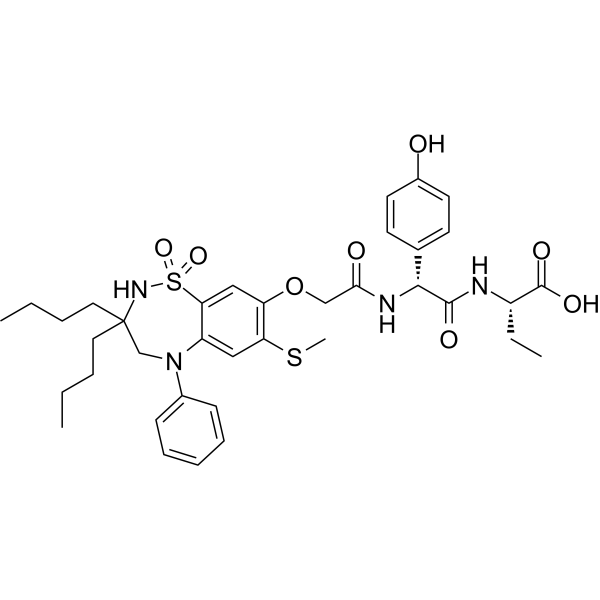
-
- HY-147838
-
|
|
NAMPT
|
Cancer
|
|
Nampt-IN-9 (Compound 8) is a potent NAMPT inhibitor with anticancer activities. Nampt-IN-9 can be used for pancreatic ductal adenocarcinoma research .
|
-

-
- HY-P1535
-
|
Porcine secretin acetate
|
Secretin Receptor
|
Inflammation/Immunology
|
|
Secretin, porcine (Porcine secretin acetate) is a 27-amino acid peptide, acting on pancreatic acinar cells and ductal epithelial cells stimulating the production of bicarbonate rich fluid.
|
-
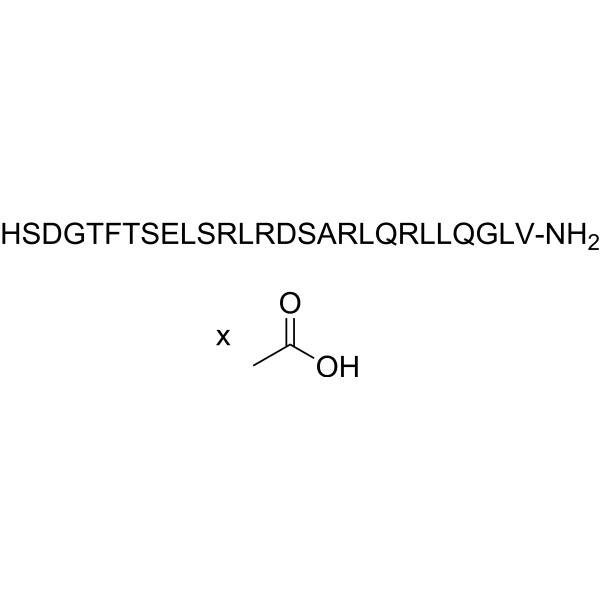
-
- HY-P1535A
-
|
Porcine secretin TFA
|
Secretin Receptor
|
Inflammation/Immunology
|
|
Secretin, porcine TFA (Porcine secretin TFA) is a 27-amino acid peptide, acting on pancreatic acinar cells and ductal epithelial cells stimulating the production of bicarbonate rich fluid .
|
-

-
- HY-156027
-
-

-
- HY-19694
-
|
|
Others
|
Endocrinology
|
|
BRD7552, a potent PDX1 transcription factor inducer, upregulates PDX1 expression in both primary human islets and ductal cells, and induces epigenetic changes in the PDX1 promoter consistent with transcriptional activation. BRD7552 increases insulin expression. PDX1 is a key transcription factor involved in pancreas development and β cell function .
|
-
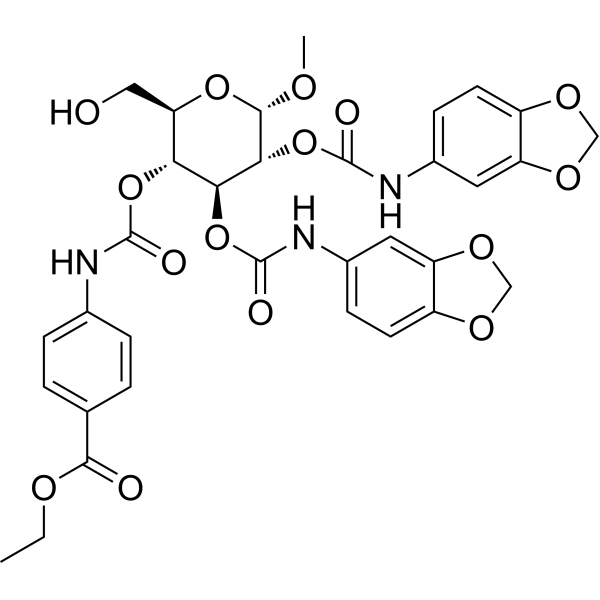
-
- HY-122723
-
|
|
Others
|
Cancer
|
|
GOT1 inhibitor-1 (compound 2c), a tryptamine-based derivative, acts as a novel, potent and non-covalent inhibitor of glutamate oxaloacetate transaminase 1 (GOT1) with an IC50 of 8.2 uM. GOT1 inhibitor-1 can be used for the research of pancreatic ductal adenocarcinoma (PDAC) .
|
-

-
- HY-P99379
-
|
CAN04; Anti-IL-1RAP/IL-1R3 Reference Antibody (nidanilimab)
|
Interleukin Related
|
Cancer
|
|
Nidanilimab (CAN04) is a fully humanized monoclonal anti-IL1RAP antibody with a Kd value of 1.10 pM. Nidanilimab blocks IL1α and IL1β signaling and stimulates the immune system to destroy tumour cells. Nidanilimab can be used in research of non-small lung cancer (NSCLC) and pancreatic ductal adenocarcinoma (PDAC) .
|
-

-
- HY-100498
-
|
|
FAK
Apoptosis
|
Cancer
|
|
GSK2256098 is a selective FAK kinase inhibitor, which inhibits growth and survival of pancreatic ductal adenocarcinoma cells.
|
-
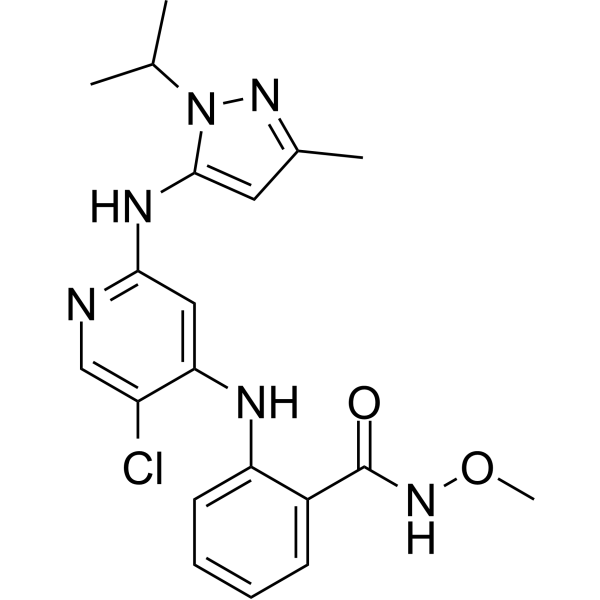
-
- HY-148260
-
|
|
Ras
|
Cancer
|
|
KRAS G12D inhibitor 16 is a KRAS G12D inhibitor. KRAS G12D inhibitor 16 has inhibitory activity against KRAS G12D and KRAS G12D mutation with IC50 value of 0.7 nM and 0.35 μM, respectively. KRAS G12D inhibitor 16 can be used for the research of many malignant tumor, such as pancreatic ductal adenocarcinomas (PDAC), colon and rectal carcinomas (CRC), non-small cell lung carcinomas (NSCLC) .
|
-
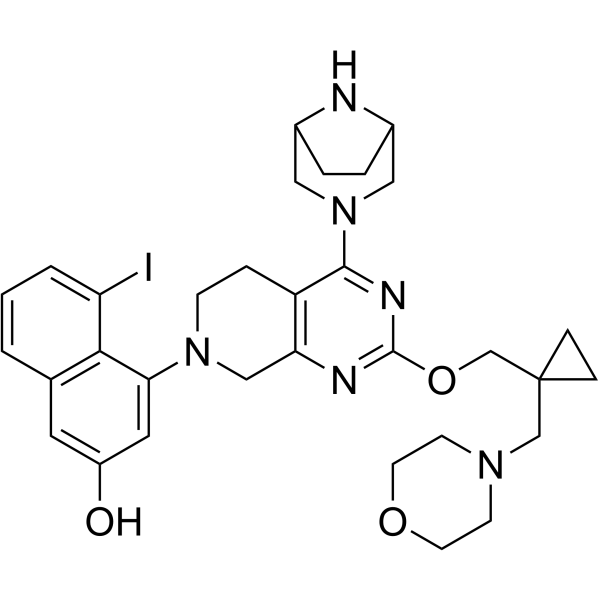
-
- HY-N1427
-
|
Sodium glycyldeoxycholate
|
|
|
|
Glycodeoxycholate Sodium (Sodium glycyldeoxycholate) is a bile salt. Glycodeoxycholate Sodium has cytotoxicity to cancer cell, changes the permeability of the pancreatic duct and decreases glucose levels .
|
-

-
- HY-A0190
-
-
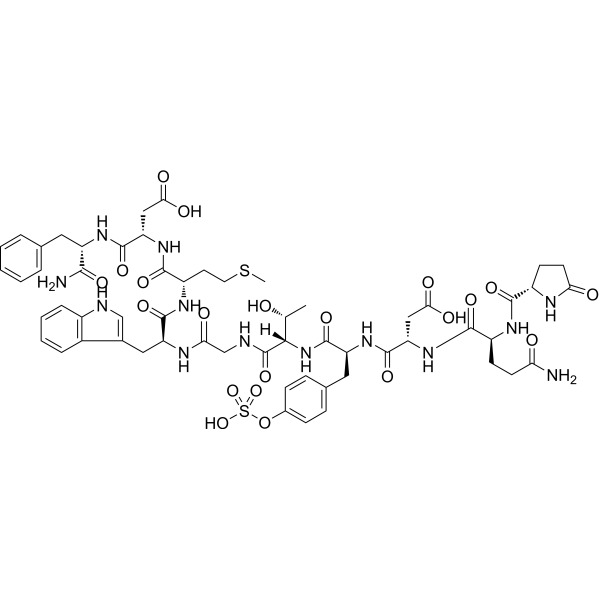
-
- HY-N10810
-
|
|
Others
|
Others
|
|
Gentioflavin is an alkaloid. Gentioflavin can be isolated from the root of Long Dan (G. scabra), a traditional substance against liver or bile duct disease .
|
-
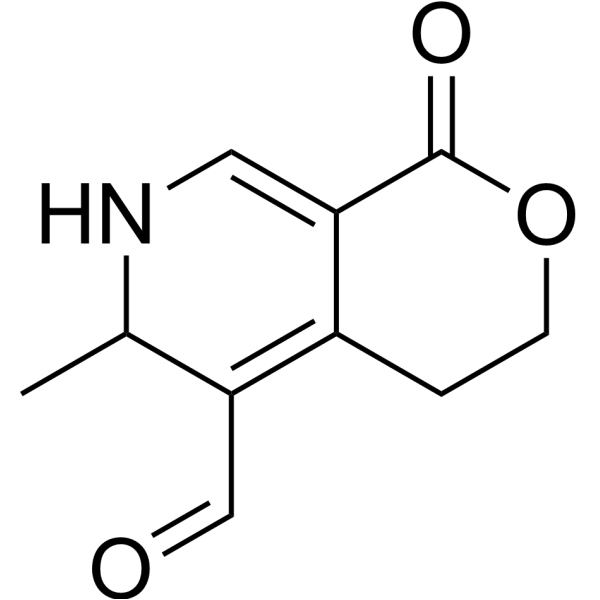
-
- HY-136750
-
|
Calpain Inhibitor IV
|
Apoptosis
Proteasome
|
Cancer
|
|
Z-LLY-FMK (Calpain Inhibitor IV) is a calpain inhibitor, involved in apoptosis of many cell systems. Z-LLY-FMK inhibits the intestine apoptosis after common bile duct ligation .
|
-

-
- HY-101194
-
|
Tin-protoporphyrin IX; Sn-Protoporphyrin; SnPPIX
|
|
|
|
Tin protoporphyrin IX dichloride (SnPPIX) is a potent Heme oxygenase-1 (HO-1) inhibitor. Tin protoporphyrin IX dichloride sensitizes pancreatic ductal adenocarcinoma (PDAC) tumors to chemotherapy in mice model .
|
-
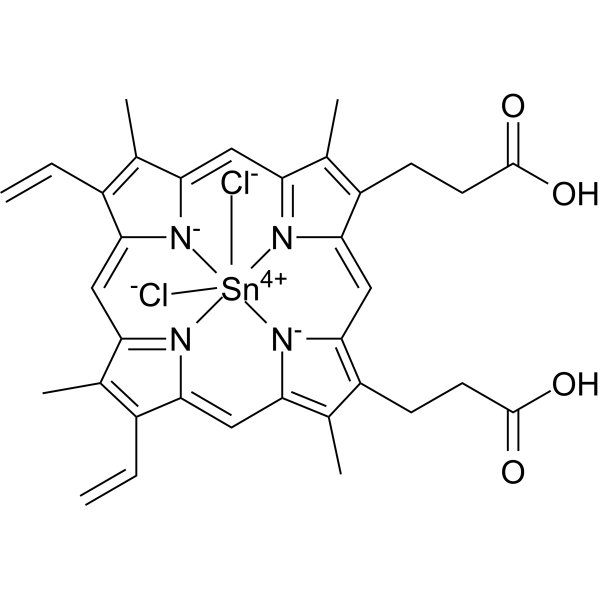
-
- HY-120396
-
|
|
5-HT Receptor
|
Neurological Disease
|
|
LY 293284 is a potent and selective 5-HT1A receptor agonist. LY 293284 results in a significant drop in core temperature and consumes more food in cholestasis rat induced by bile duct resection .
|
-
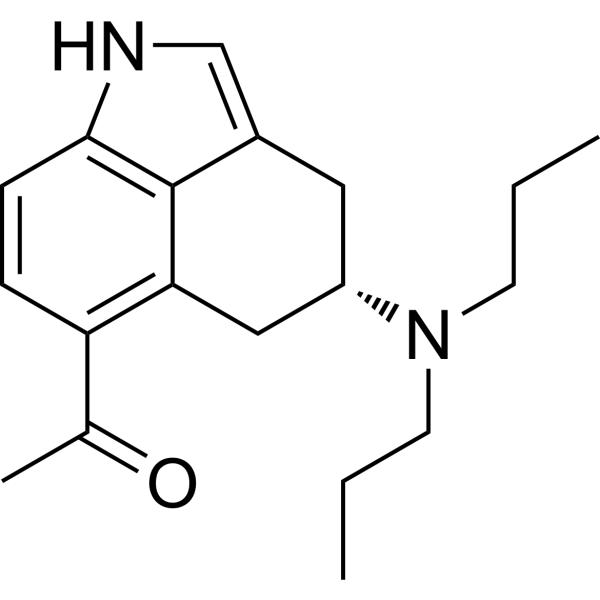
-
- HY-B0149S3
-
|
Cyclocapron-13C2,15N
|
Isotope-Labeled Compounds
|
Inflammation/Immunology
|
|
Tranexamic acid- 13C2, 15N (Cyclocapron- 13C2, 15N) is the 13C2 and 15N labeled Tranexamic acid. Tranexamic acid is an antifibrinolytic agent that alleviates liver damage and fibrosis in mouse models of chronic bile duct injury .
|
-

-
- HY-B1557
-
|
Ametazole
|
|
|
|
Betazole (Ametazole), a pyrazole analogue of histamine, is an orally active histamine H2 receptor agonist. Betazole induces gastric acid secretion and causes an immediate and significant increase in common bile duct pressure. Betazole is used as a diagnostic agent known as histalog for investigating gastric acid secretory capacity .
|
-
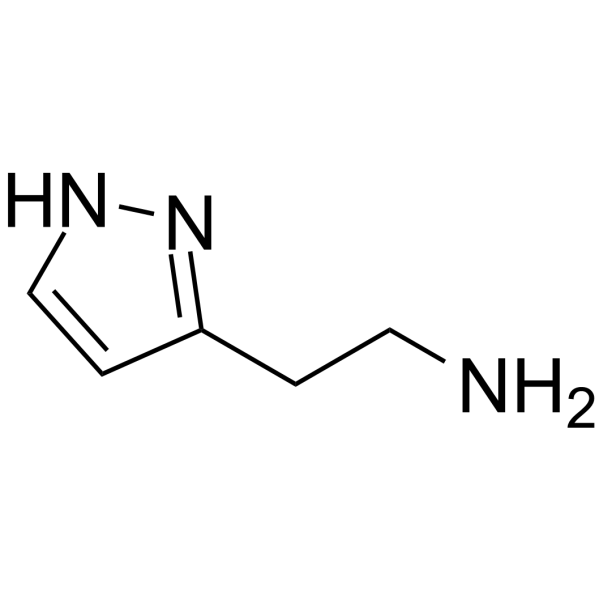
-
- HY-B1557A
-
|
Ametazole dihydrochloride
|
|
|
|
Betazole (Ametazole) dihydrochloride, a pyrazole analogue of histamine, is an orally active H2 receptor agonist. Betazole dihydrochloride induces gastric acid secretion, and causes an immediate and significant increase in common bile duct pressure. Betazole dihydrochloride has been used as a diagnostic agent known as histalog, for investigating gastric acid secretory capacity .
|
-
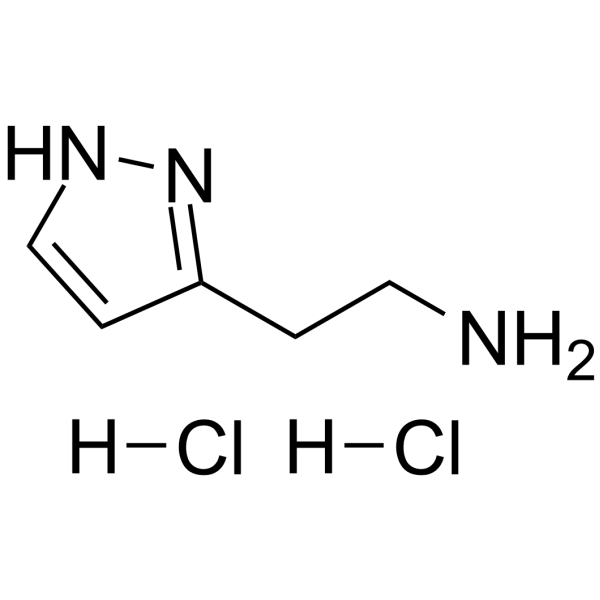
-
- HY-N6237
-
|
|
Reactive Oxygen Species
|
Infection
|
|
Aspulvinone O is a natural inhibitor of aspartate transaminase 1 (GOT1). GOT1 plays an important role in energy metabolism and Reactive Oxygen Species (ROS) balance. GOT1 may serve as an important target in PDAC. Aspulvinone O suppresses pancreatic ductal adenocarcinoma cells growth by interfering glutamine metabolism .
|
-
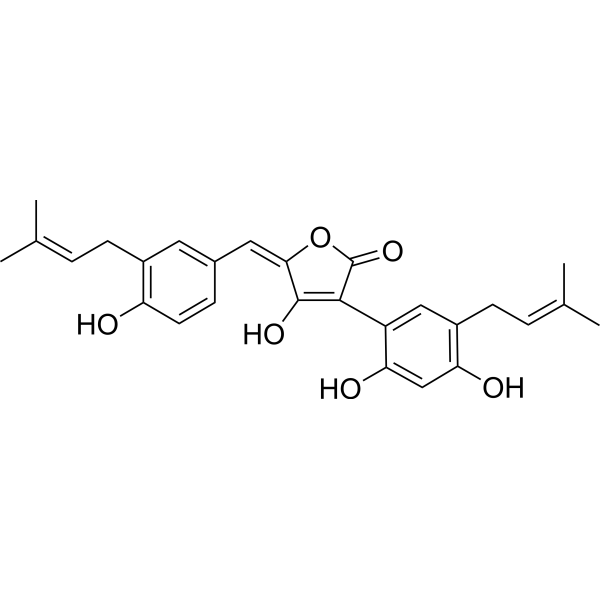
-
- HY-160045
-
|
|
Cholecystokinin Receptor
|
Cancer
|
|
AP1153 aptamer sodium is a DNA aptamer that specifically binds to the cholecystokinin receptor CCKBR (Kd: ~15 pM), but does not activate CCKBR-related signaling pathways. AP1153 aptamer sodium is internalized by pancreatic ductal adenocarcinoma (PDAC) cells in a receptor-mediated manner. AP1153 aptamer sodium can bioconjugate to the surface of fluorescent nanoparticles to facilitate nanoparticle delivery to PDAC tumors in vivo .
|
-
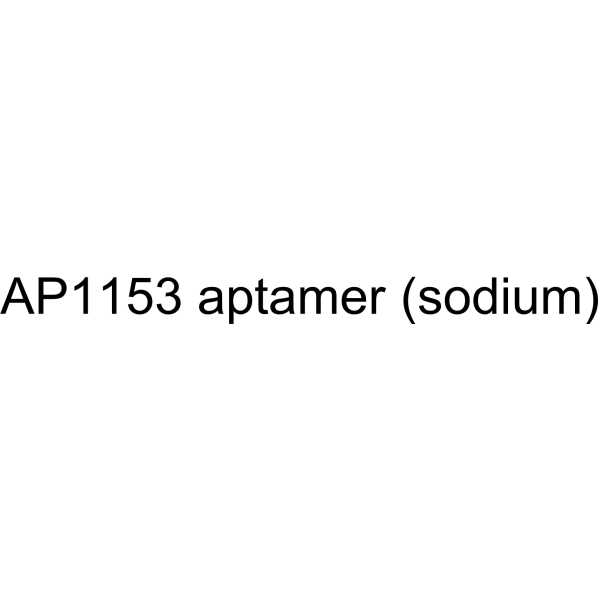
-
- HY-139562
-
|
|
FXR
|
Metabolic Disease
|
|
BMS-986318 is a potent nonbile acid FXR agonist with EC50s of 53 and 350 nM in the FXR Gal4 and SRC-1 recruitment assays, respectively. BMS-986318 has a suitable ADME profile, and demonstrates efficacy in the mouse bile duct ligation model of liver cholestasis and fibrosis.BMS-986318 can be used for the research of nonalcoholic steatohepatitis .
|
-

-
- HY-161346
-
|
|
ADC Cytotoxin
Epigenetic Reader Domain
|
Cancer
|
|
EBET-1055 is a bromodomain and extra-terminal (BET) protein degrader (EBET) composed of a BET inhibitor (EBET-590, HY-161387), an E3 ubiquitin ligase ligand and connectors. EBET-1055 effectively inhibits the growth of pancreatic ductal adenocarcinoma (PDAC). EBET-1055 also simultaneously modulates cancer-associated fibroblast (CAF) activity, upregulating all reporter gene activities in organoid co-cultures .
|
-

-
- HY-147008
-
|
|
Epigenetic Reader Domain
|
Cancer
|
|
XP-524 is a potent BET and EP300 inhibitor. XP-524 shows great tumoricidal activity in vivo. XP-524 prevents KRAS-induced, neoplastic transformation in vivo and extends survival in two transgenic mouse models of aggressive PDAC. XP-524 also enhances the presentation of self-peptide and tumor recruitment of cytotoxic T lymphocytes. XP-524 has the potential for the research of pancreatic ductal adenocarcinoma (PDAC) .
|
-
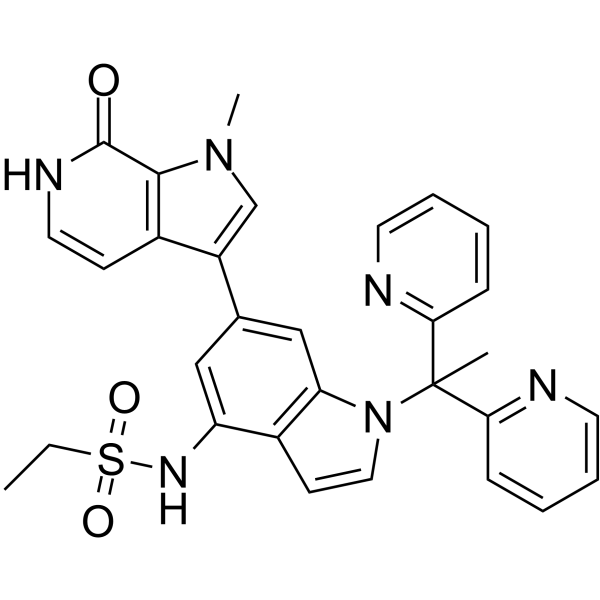
-
- HY-100669
-
Mycro 3
5 Publications Verification
|
c-Myc
Autophagy
|
Cancer
|
|
Mycro 3 is an orally active, potent and selective inhibitor of Myc-associated factor X (MAX) dimerization. Mycro 3 also inhibit DNA binding of c-Myc . Mycro 3 could be used for the research of pancreatic cancer .
|
-
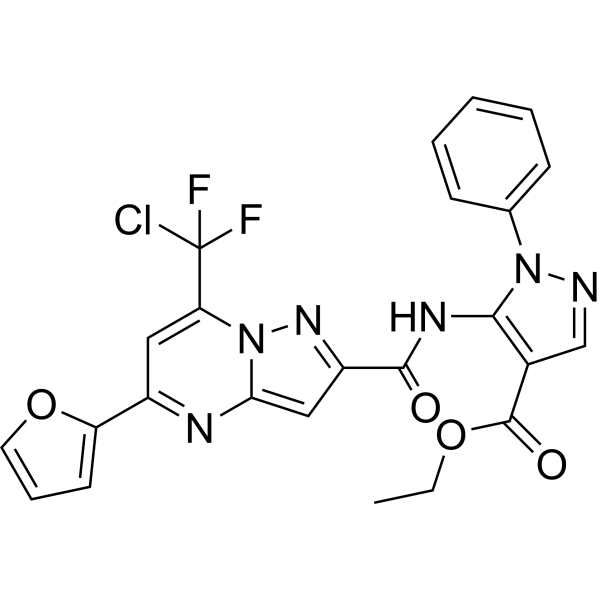
-
- HY-135985
-
|
|
Others
|
Cancer
|
|
DCLK1-IN-1 is a selective, oral bioavailability in vivo-compatible chemical probe of the doublecortin like kinase 1 (DCLK1 kinase) domain. DCLK1-IN-1 inhibits DCLK1 and DCLK2 kinases (IC50: DCLK1=9.5/57.2 nM and DCLK2=31/103 nM in binding and kinase assay, respectively). DCLK1-IN-1 shows low toxicity, and can investigate DCLK1 biology and establish its role in cancer, like DCLK1 + pancreatic ductal adenocarcinoma (PDAC) .
|
-
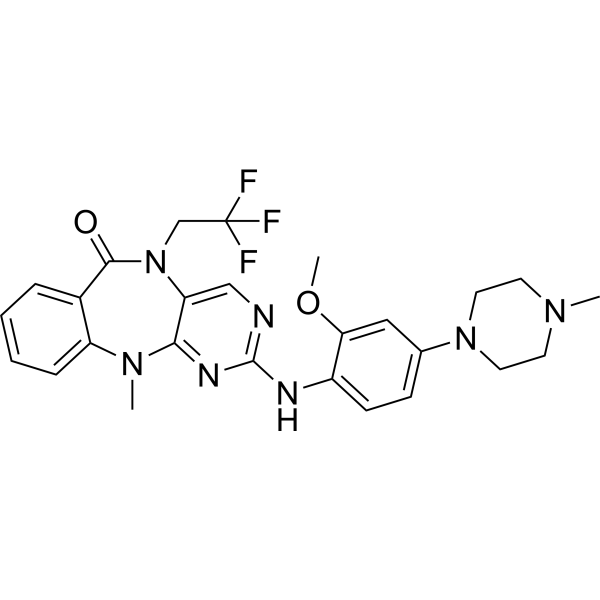
-
- HY-19808
-
-

-
- HY-120272
-
|
DT-1154
|
Phosphatase
|
Cancer
|
|
SMAP-2 (DT-1154) is an orally active protein phosphatase 2A (PP2A) activator, with anti-cancer activity .
|
-
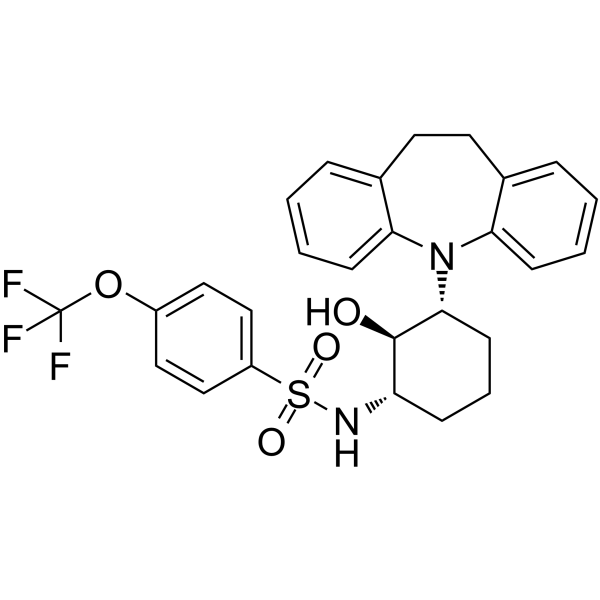
-
- HY-121667
-
|
|
ROCK
|
Cancer
|
|
Scaff10-8, bound to RhoA, inhibits the AKAP-Lbc-mediated RhoA activation .
|
-
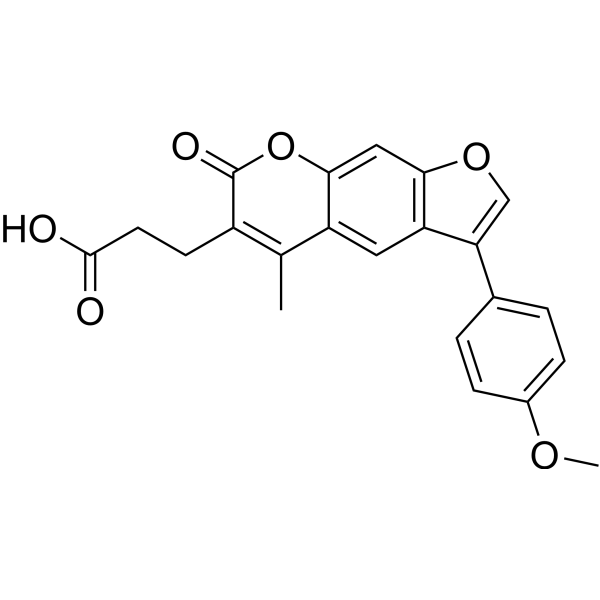
-
- HY-148409
-
|
|
Ferroptosis
Apoptosis
Autophagy
MDM-2/p53
|
Cancer
|
|
MMRi62, a ferroptosis inducer targeting MDM2-MDM4 (negative regulators of tumor suppressor p53). MMRi62 shows a P53-independent pro-apoptotic activity against pancreatic ductal adenocarcinoma (PDAC) cells and induce autophagy. MMRi62 inducesferroptosis, resulting in a increase of reactive oxygen and lysosomal degradation of ferritin heavy chain (FTH1). MMRi62 also leads to proteasomal degradation of mutant p53, also inhibits orthotopic xenograft PDAC mouse model in vivo with high frequency mutation characteristics of KRAS and TP53.12 .
|
-
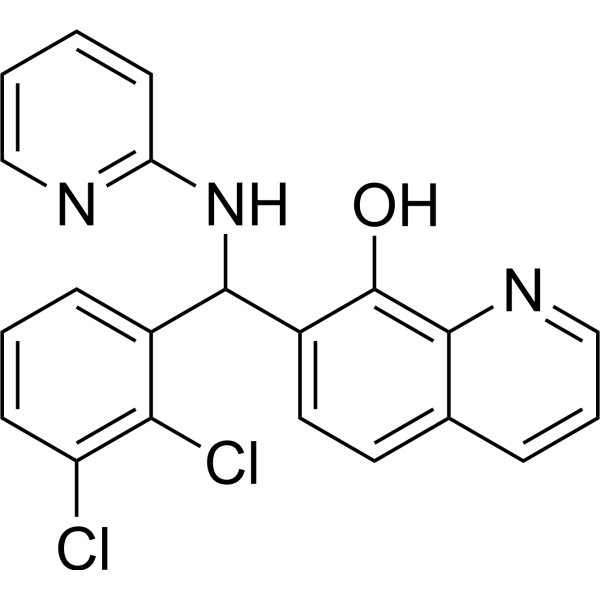
-
- HY-101473
-
|
|
Integrin
|
Inflammation/Immunology
|
|
EMD527040 is a potent and highly selective αvβ6 antagonist with antifibrotic activities. EMD527040 can be used for carcinoma and liver fibrosis research .
|
-
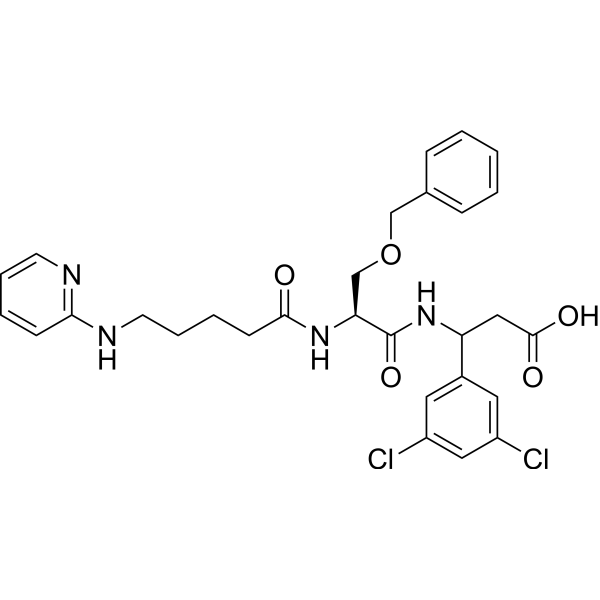
-
- HY-P1676
-
|
BK-1361
|
MMP
|
Cancer
|
|
cyclo(RLsKDK) (BK-1361) is a specific inhibitor of metalloproteinase ADAM8 with an IC50 value of 182 nM. cyclo(RLsKDK) has potential applications in inflammatory diseases and cancer .
|
-
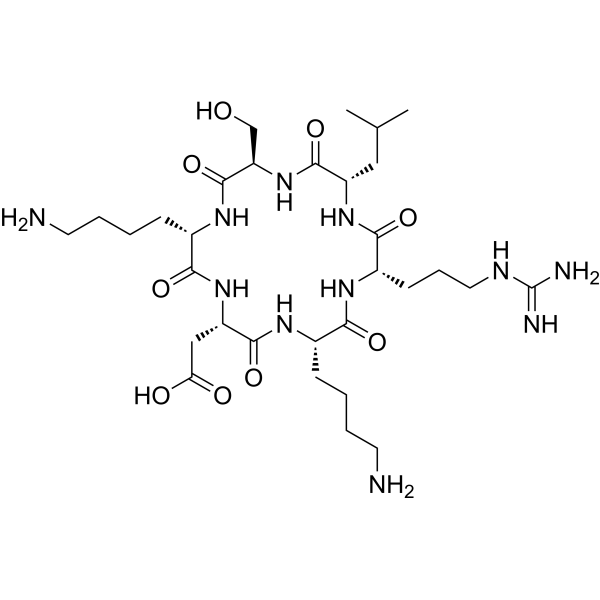
-
- HY-P1676A
-
|
BK-1361 TFA
|
MMP
|
Cancer
|
|
cyclo(RLsKDK) (TFA) (BK-1361 (TFA)) is a specific inhibitor of metalloproteinase ADAM8 with an IC50 value of 182 nM. cyclo(RLsKDK) (TFA) has potential applications in inflammatory diseases and cancer .
|
-
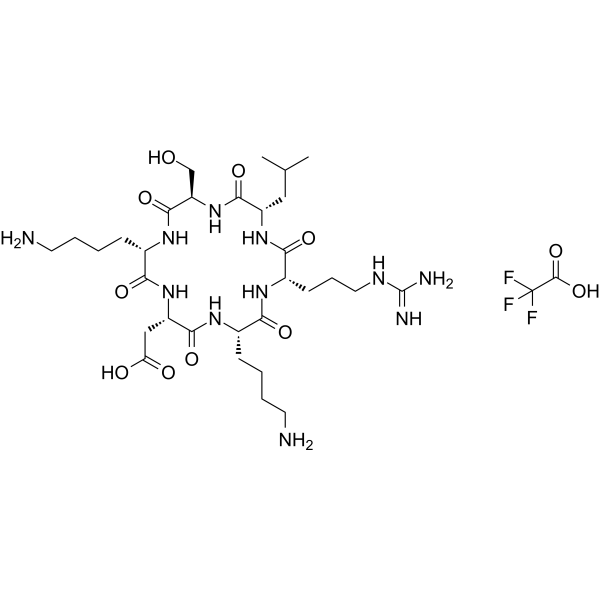
-
- HY-160049
-
|
|
Others
|
Cancer
|
|
BC15 aptamer sodium is an ssDNA aptamer targeting the intracellular protein hnRNP A1, which is highly expressed in cancerous liver tissue. BC15 aptamer sodium specifically recognizes breast cancer cells and can be used to detect cancer cells in other pathological types of breast cancer tissue .
|
-
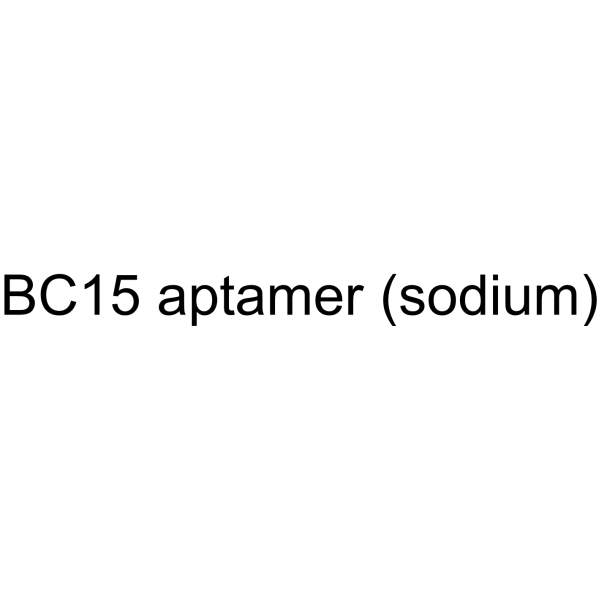
-
- HY-136453
-
|
|
Eukaryotic Initiation Factor (eIF)
Apoptosis
|
Cancer
|
|
CR-1-31-B is a synthetic rocaglate and a potent eIF4A inhibitor. CR-1-31-B exhibits powerful inhibitory effects over eIF4A by perturbing the interaction between eIF4A and RNA, sequentially impeding initiation during protein synthesis. CR-1-31-B perturbs association of Plasmodium falciparum eIF4A (PfeIF4A) with RNA. CR-1-31-B induces apoptosis of neuroblastoma and gallbladder cancer cells .
|
-
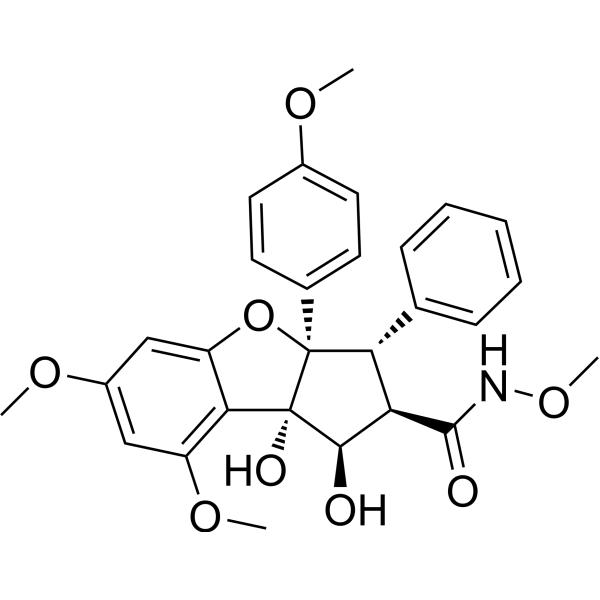
-
- HY-10805
-
|
ACT 078573
|
Orexin Receptor (OX Receptor)
Calcium Channel
Caspase
Apoptosis
|
Neurological Disease
Endocrinology
Cancer
|
|
Almorexant (ACT 078573) is an orally active, potent and competitive dual orexin receptor antagonist, with Kd values of 1.3 nM (OX1) and 0.17 nM (OX2), respectively. Almorexant reversibly blocks signaling of orexin-A and orexin-B peptides. Almorexant totally blocked the intracellular Ca 2+ signal pathway. Almorexant stimulates caspase-3 activity in AsPC-1 cells and induces apoptosis .
|
-

-
- HY-10805A
-
|
ACT 078573 hydrochloride
|
Orexin Receptor (OX Receptor)
Calcium Channel
Caspase
Apoptosis
|
Neurological Disease
Endocrinology
Cancer
|
|
Almorexant (ACT 078573) hydrochloride is an orally active, potent and competitive dual orexin receptor antagonist, with Kd values of 1.3 nM (OX1) and 0.17 nM (OX2), respectively. Almorexant hydrochloride reversibly blocks signaling of orexin-A and orexin-B peptides. Almorexant hydrochloride totally blocked the intracellular Ca 2+ signal pathway. Almorexant hydrochloride stimulates caspase-3 activity in AsPC-1 cells and induces apoptosis .
|
-

| Cat. No. |
Product Name |
Target |
Research Area |
-
- HY-A0190
-
-
- HY-P1535
-
|
Porcine secretin acetate
|
Secretin Receptor
|
Inflammation/Immunology
|
|
Secretin, porcine (Porcine secretin acetate) is a 27-amino acid peptide, acting on pancreatic acinar cells and ductal epithelial cells stimulating the production of bicarbonate rich fluid.
|
-
- HY-P1535A
-
|
Porcine secretin TFA
|
Secretin Receptor
|
Inflammation/Immunology
|
|
Secretin, porcine TFA (Porcine secretin TFA) is a 27-amino acid peptide, acting on pancreatic acinar cells and ductal epithelial cells stimulating the production of bicarbonate rich fluid .
|
-
- HY-P5291
-
|
Caerulein precursor fragment
|
Peptides
|
Metabolic Disease
|
|
CPF-7 (Caerulein precursor fragment) is an insulin-releasing peptide that stimulates the release of insulin. CPF-7 can induce epithelial-mesenchymal transition by upregulating Snai1 expression in PANC-1 ductal cells. CPF-7 also induces exocrine plasticity by upregulating Ngn3 expression. CPF-7 can be used in the research of type 2 diabetes .
|
-
- HY-P5513
-
|
|
Peptides
|
Others
|
|
Aquaporin-2 (254-267), pSER261, human is a biological active peptide. (This peptide is a fragment of the human aquaporin-2 (AQP2) phosphorylated at Ser261. Protein phosphorylation plays a key role in vasopressin signaling in renal-collecting duct. Phosphorylation at several AQP2 residues including Ser256 and Ser261, is altered in response to vasopressin. It is possible that both sites are involved in vasopressin-dependent AQP2 trafficking.)
|
-
- HY-P3203
-
|
|
Peptides
|
Inflammation/Immunology
|
|
DSTYSLSSTLTLSK is a generic human peptide and can be used for infliximab quantitative detection . Infliximab (Avakine) is a chimeric monoclonal IgG1 antibody that specifically binds to TNF-α.
|
-
- HY-P1676
-
|
BK-1361
|
MMP
|
Cancer
|
|
cyclo(RLsKDK) (BK-1361) is a specific inhibitor of metalloproteinase ADAM8 with an IC50 value of 182 nM. cyclo(RLsKDK) has potential applications in inflammatory diseases and cancer .
|
-
- HY-P1676A
-
|
BK-1361 TFA
|
MMP
|
Cancer
|
|
cyclo(RLsKDK) (TFA) (BK-1361 (TFA)) is a specific inhibitor of metalloproteinase ADAM8 with an IC50 value of 182 nM. cyclo(RLsKDK) (TFA) has potential applications in inflammatory diseases and cancer .
|
-
- HY-K6117
-
|
|
|
MCE Human Liver Ductal Organoid Kit contains Human Liver Ductal Organoid Basal Medium A, Human Liver Ductal Organoid Supplement B (50x),
Human Liver Ductal Organoid Supplement C (250x). This product can be used to efficiently construct human liver ductal organoid.
|
-
- HY-K6118
-
|
|
|
MCE Mouse Liver Ductal Organoid Kit contains Mouse Liver Ductal Organoid (expansion) Basal Medium A, Mouse Liver Ductal Organoid (expansion)
Supplement B (50x), Mouse Liver Ductal Organoid (expansion) Supplement C (250x). This product can be used to efficiently construct mouse liver
ductal organoid.
|
| Cat. No. |
Product Name |
Target |
Research Area |
-
- HY-P99379
-
|
CAN04; Anti-IL-1RAP/IL-1R3 Reference Antibody (nidanilimab)
|
Interleukin Related
|
Cancer
|
|
Nidanilimab (CAN04) is a fully humanized monoclonal anti-IL1RAP antibody with a Kd value of 1.10 pM. Nidanilimab blocks IL1α and IL1β signaling and stimulates the immune system to destroy tumour cells. Nidanilimab can be used in research of non-small lung cancer (NSCLC) and pancreatic ductal adenocarcinoma (PDAC) .
|
| Cat. No. |
Product Name |
Category |
Target |
Chemical Structure |
| Cat. No. |
Product Name |
Chemical Structure |
-
- HY-B0149S3
-
|
|
|
Tranexamic acid- 13C2, 15N (Cyclocapron- 13C2, 15N) is the 13C2 and 15N labeled Tranexamic acid. Tranexamic acid is an antifibrinolytic agent that alleviates liver damage and fibrosis in mouse models of chronic bile duct injury .
|
-

Your information is safe with us. * Required Fields.
Inquiry Information
- Product Name:
- Cat. No.:
- Quantity:
- MCE Japan Authorized Agent:













































